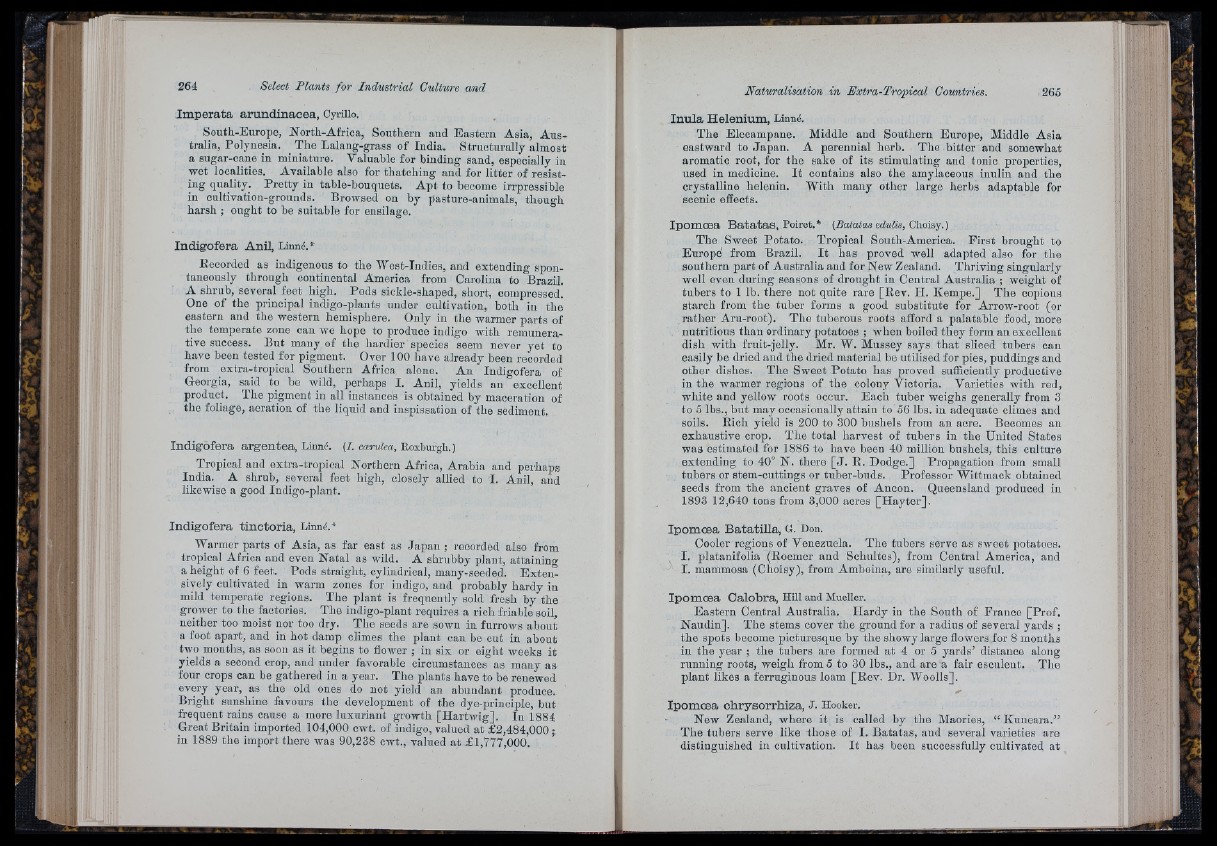
Imperata arundinacea, Cyrillo.
South-Europe, North-Africa, Southern and Eastern Asia, Australia,
Polynesia. The Lalang-grass of India. Structurally almost
a sugar-cane in miniature. Valuable for binding sand, especially in
wet localities. Available also for thatching and for litter of resisting
quality. Pretty in table-bouquets. Apt to become irrpressible
in cultivation-grouuds. Browsed on by pasture-animals, though
harsh ; ought to be suitable for ensilage.
Indigofera Anil, Linué.*
Recorded as indigenous to the West-Indies, and extending spontaneously
through continental America from Carolina to Brazil.
A shrub, several feet high. Pods sickle-shaped, short, compressed.
One of the principal indigo-plants under cultivation, both in the
eastern and the western hemisphere. Only in the warmer parts of
the temperate zone can we liope to produce indigo with remunerative
success. But many of the hardier species seem never yet to
have been tested for pigment. Over 100 have already been recorded
from extra-tropical Southern Africa alone. An ludigofera of
Georgia, said to be wild, perhaps I. Anil, yields an excellent
product. The pigment in all instances is obtained by maceration of
the foliage, aeration of tbe liquid and inspissation of the sediment.
Indigofera argentea, Linné. (I. cerulea, Roxburgh.)
Tropical and extra-tropical Northern Africa, Arabia and perhaps
India. A shrub, several feet high, closely allied to I. Anil, aud
likewise a good Indigo-plant.
Indigofera tinctoria, Linné.*
Warmer parts of Asia, as far east as Japan ; recorded also from
tropical Africa and even Natal as wild. A shrubby plant, attaining
a height of 6 feet. Pods straight, cylindrical, many-seeded. E x ten sively
cultivated in warm zones for indigo, and probably hardy in
mild temperate regions. The plant is frequently sold fresh by the
grower to the factories. The indigo-plant requires a ricli friable soil,
neither too moist nor too dry. The seeds are sown in furrows about
a foot apart, and in hot damp climes the plant can be cut in about
two months, as soon as it begins to flower ; in six or eight weeks it
yields a second crop, and under favorable circumstances as many as
four crops can be gathered in a year. The plants have to be renewed
every year, as the old ones do not yield an abundant produce.
Bright sunshine favours the development of the dye-principle, but
frequent rains cause a more luxuriant growth [H a rtw ig ]. In 1884
Great Britain imported 104,000 cwt. of indigo, valued at £2,484,000;,
in 1889 the import there was 90,238 cwt., valued a t £1,777,000.
Inula Helenium, Linné.
The Elecampane. Middle and Southern Europe, Middle Asia
eastward to Jap an . A perennial herb. The bitter and somewhat
aromatic root, for the sake of its stimulating aud tonic properties,
used in medicine. I t contains also the amylaceous inulin and the
crystalline helenin. With many other large herbs adaptable for
scenic efleots.
Ipomoea Batatas, Poiret.* (Batatas edulis, Choisj.)
The Sweet Potato. Tropical South-America. F irst brought to
Europe from Brazil. I t has proved well adapted also for the
southern part of Australia and for New Zealand. Thriving singularly
well even during seasons of drought iu Central Australia ; weight of
tubers to 1 lb. there not quite rare [Rev. H. Kempe.] The copious
starch from the tuber forms a good substitute for Arrow-root (or
rather Aru-root). The tuberous roots afford a palatable food, more
nutritious than ordinary potatoes ; when boiled they form an excellent
dish with frnit-jelly. Mr. W. Mussey says th a t sliced tubers can
easily be dried and the dried material be utilised for pies, puddings and
other dishes. The Sweet Potato has proved suffloiently productive
in the warmer regions of the colony Victoria. Varieties with red,
white and yellow roots occur. Each tuber weighs generally from 3
to 5 lbs., but may occasionally attain to 56 lbs. in adequate climes and
soils. Rich yield is 200 to 300 bushels from an acre. Becomes an
exhaustive crop. Tlie total harvest of tubers iu the United States
was estimated for 1886 to have been 40 million bushels, this culture
extending to 40° N. there [ J . E. Dodge.] Propagation from small
tubers or stem-outtings or tiiber-buds. Professor Wittmack obtained
seeds from the ancient graves of Ancon. Queensland produced in
1893 12,640 tons from 3,000 acres [H ay te r].
Ipomoea Batatilla, C. Don.
Cooler regions of Venezuela. The tubers serve as sweet potatoes.
I. platanifolia (Roemer and Schultes), from Central America, and
I. mammosa (Choisy), from Amboina, are similarly useful.
Ipomoea Calobra, H ill and Mueller.
Eastern Central Australia. Hardy in the South of France [Prof.
Naudin]. The stems cover the ground for a radius of several yards ;
the spots become picturesque by the showy large flowers for 8 months
in the year ; the tubers are formed at 4 or 5 yards’ distance along
running roots, weigh from 5 to 30 lbs., and are a fair esculent. The
plant likes a ferruginous loam [Rev. Dr. Woolls].
Ipomcea chrysorrhiza, J. Hooker.
New Zealand, where it is called by the Maories, “ Kuneara.”
The tubers serve like those of I . Batatas, and several varieties are
distinguished in cultivation. I t has been suoeessfully cultivated at